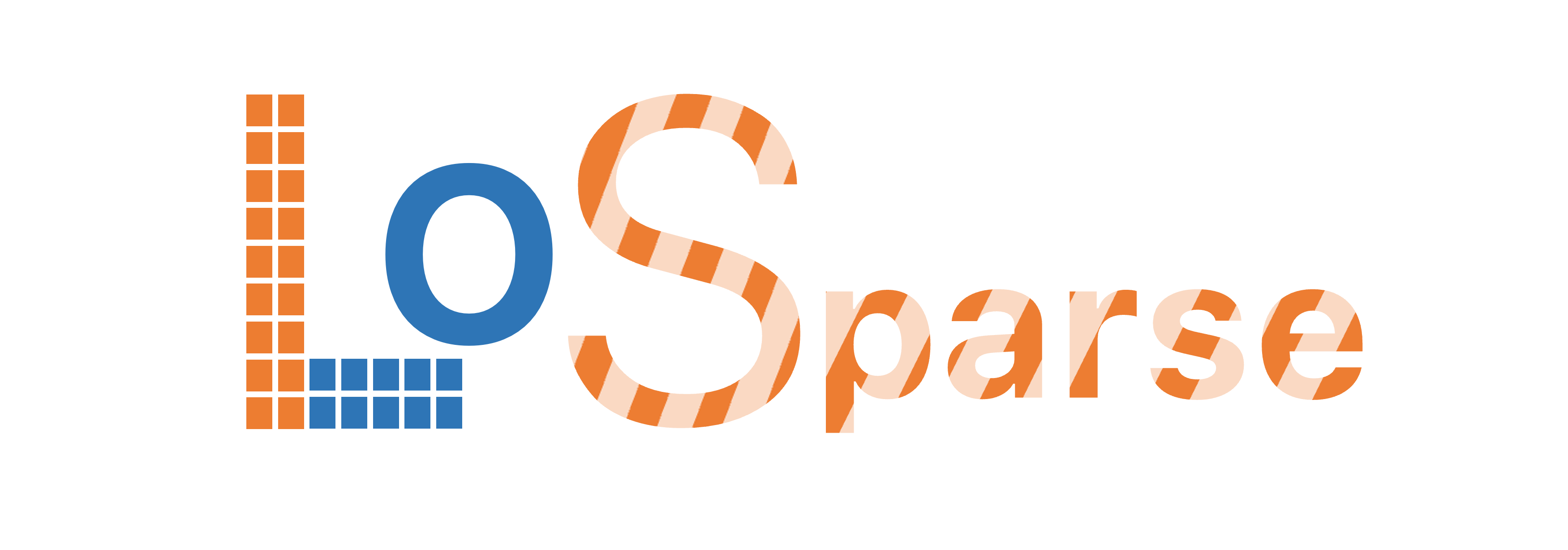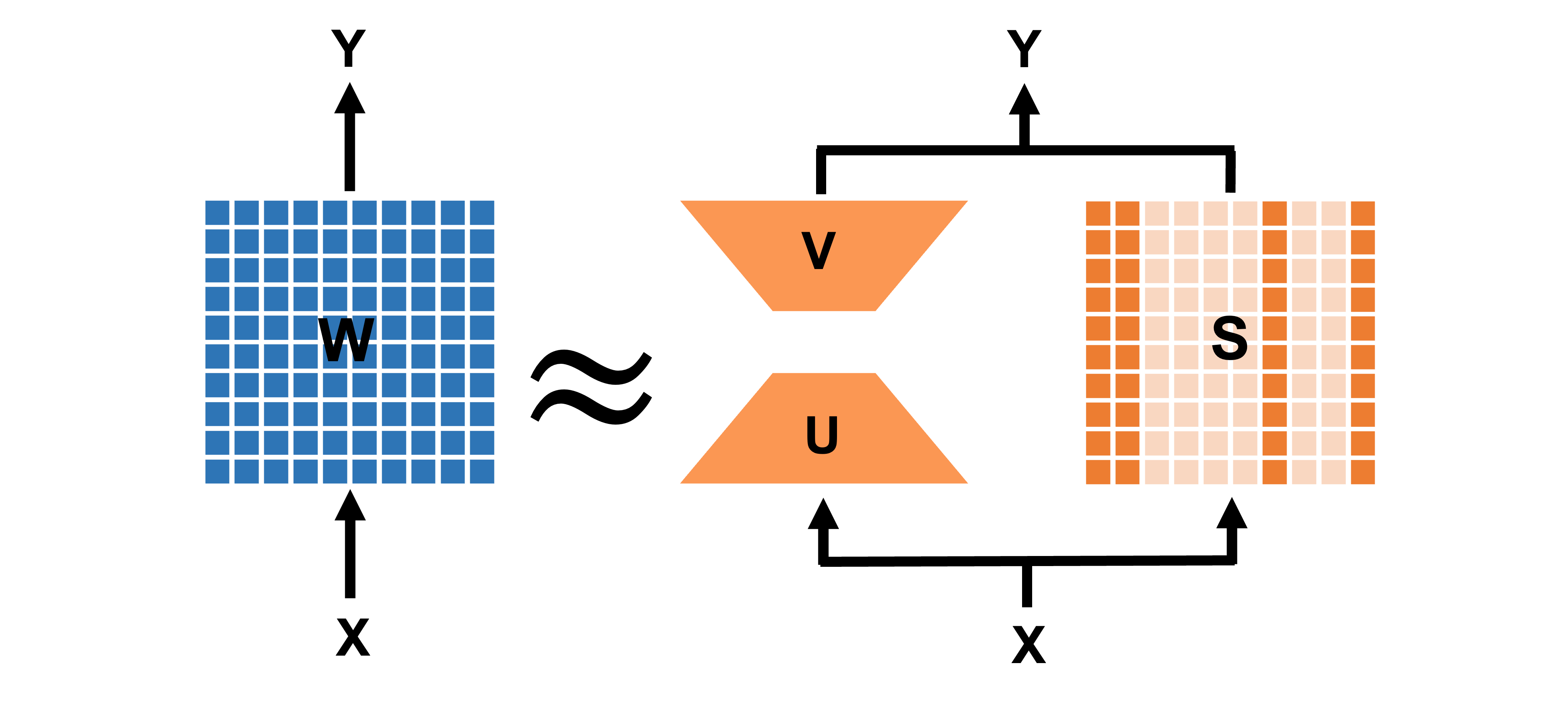This pytorch package implements LoSparse: Structured Compression of Large Language Models based on Low-Rank and Sparse Approximation (ICML 2023).
A highly efficient compression method combining structured pruning and low-rank approximation.
We use a low-rank matrix which can be decomposed into two small matrices and a structured sparse matrix to approximate the weight matrix during the downstream task fine-tuning. The diagram is illustrated in below:
DeBERTa-v3-base on GLUE w/o knowledge distillation
| Ratio | MNLI | RTE | QNLI | MRPC | QQP | SST-2 | CoLA | STS-B |
|---|---|---|---|---|---|---|---|---|
| 100%* | 90.5/90.6 | 82.0 | 94.0 | 89.5 / 93.3 | 92.4/89.8 | 95.3 | 69.2 | 91.6/91.1 |
| 20% | 84.5/83.8 | 68.0 | 88.6 | 85.0/89.4 | 90.6/87.2 | 91.7 | 50.0 | 88.8/88.5 |
| 15% | 83.3/82.9 | 66.9 | 87.6 | 83.6/88.0 | 90.3/87.0 | 90.4 | 46.8 | 87.7/87.3 |
| 10% | 81.7/81.8 | 66.0 | 86.1 | 82.3/87.4 | 89.5/86.0 | 89.2 | 40.0 | 87.2/87.0 |
*: full model fine-tuning
DeBERTa-v3-base on SQuAD v1.1 w/o knowledge distillation
| Ratio | 5% | 10% | 20% | 30% | 40% | 50% |
|---|---|---|---|---|---|---|
| 69.3/79.1 | 72.9/82.8 | 76.8/85.8 | 80.2/88.0 | 82.1/89.4 | 82.3/90.3 |
BART-large on CNN/DailyMail and XSum w/o knowledge distillation
| Ratio | XSum | CNN/DailyMail |
|---|---|---|
| Lead-3* | 16.30/1.60/11.95 | 40.42/17.62/36.67 |
| 100%** | 45.14/22.27/37.25 | 44.16/21.28/40.90 |
| 50% | 39.18/16.91/31.62 | 41.54/19.04/38.58 |
| 40% | 38.30/16.02/30.72 | 41.42/19.00/38.47 |
| 30% | 37.41/15.42/30.02 | 41.21/18.84/38.21 |
*: Using the first 3 sentences in the document as the summary
**: full model fine-tuning
We use huggingface 🤗 as our training code scripts. See examples here
pip install -r requirements.txt
- GLUE:
run_glue.py - Question Answering:
run_qa.py - Summarization:
run_summarization.py
An example command for training on GLUE dataset is:
python run_glue.py \
--dataset_name \
We provided sample training script in: train_glue.sh, train_qa.sh, train_summarization.sh. Additionally, we provide the distillation script for the glue experiments in train_glue_distil.sh. You can also do quick eval on some sample checkpoints we release by substituting the path for eval_checkpoint in eval_glue.sh and eval_glue_distil.sh.
The checkpoints are shown below
DeBERTa-v3-base and BERT-base on GLUE w/o knowledge distillation
| Model Name | TASK | Parameter ratio | Performance |
|---|---|---|---|
| deberta_mnli_20 | MNLI | 20 | 84.6 |
| deberta_mnli_15 | MNLI | 15 | 83.3 |
| deberta_mnli_10 | MNLI | 10 | 81.6 |
| deberta_rte_20 | RTE | 20 | 69.0 |
| deberta_rte_15 | RTE | 15 | 67.1 |
| deberta_rte_10 | RTE | 10 | 66.8 |
| deberta_cola_20 | COLA | 20 | 50.7 |
| deberta_cola_15 | COLA | 15 | 46.6 |
| deberta_cola_10 | COLA | 10 | 40.6 |
| deberta_stsb_20 | STSB | 20 | 89.0 / 88.6 |
| deberta_stsb_15 | STSB | 15 | 87.9 / 87.5 |
| deberta_stsb_10 | STSB | 10 | 87.2 / 86.8 |
| bert_rte_20 | RTE | 20 | 66.1.7 |
| bert_rte_15 | RTR | 15 | 64.6 |
| bert_rte_10 | RTE | 10 | 63.2 |
BERT-base on GLUE with knowledge distillation
| Model Name | TASK | Parameter ratio | Performance |
|---|---|---|---|
| bert_mnli_25_distil | MNLI | 25 | 84.6 |
| bert_mnli_50_distil | MNLI | 50 | 85.1 |
| bert_rte_50_distil | RTE | 50 | 75.8 |
You can easily download the checkpoints through wget command
--low_rank_parameter_ratio: The proportion of retained low-rank matrix parameters. For example: 0.10--final_threshold: The proportion of retained sparse matrix parameters. For example: 0.20--deltaT: prune everydeltaTsteps
--initial_warmup: steps that do not prune; fine-tuning only--final_warmup: steps that do not decrease the pruning ratio--beta1: moving average coefficient of the importance score--stored_model_path: only used during distillation; the path for the pruned model that want to be distilled--teacher_path: only used during distillation; the path of the teacher model
3 steps to apply our method to your code. Make sure you have import utils first.
Insert the following code after loaded the pre-training model
# Substitute weights with low rank matrix and sparse matrix
allow_name = ['query', 'key', 'value', 'q_proj', 'k_proj', 'v_proj', 'out_proj', 'dense', 'attention', 'fc1', 'fc2']
block_name = ['pooler', 'classifier', 'LayerNorm', 'embeddings']
utils.substitute_layer_weights(module=model,
allow_name=allow_name,
block_name=block_name,
parameter_ratio=args.low_rank_parameter_ratio,
do_svd=True)Insert the following code anywhere before the training loop
pruner = utils.Pruner(model=model,
args=args,
total_step=args.max_train_steps,
mask_param_name=['sparse'],
pruner_name='PLATON',
structured_method=args.structured_method,
structured_direction=args.structured_direction)Insert threshold, mask_threshold = pruner.update_and_pruning(model, completed_steps) after loss.backward() but before optimizer.zero_grad(). For example:
for batch in dataloader:
outputs = model(**batch)
loss = outputs.loss
loss.backward()
optimizer.step()
# Prune the sparse matrix
threshold, mask_threshold = pruner.update_and_pruning(model, completed_steps)
lr_scheduler.step()
optimizer.zero_grad()
